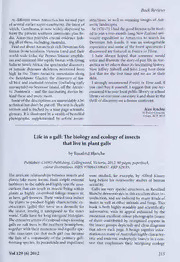
Life in a gall: The biology and ecology of insects that live in plant galls [Book Review] PDF
Preview Life in a gall: The biology and ecology of insects that live in plant galls [Book Review]
BookReviews Atdifferent times Antarcticahas formedpart structions, as well as stunning images ofAnt- ofseveral earliersuper-continents, thelatestof arcticlandscapes. which, Gondwana, is now widely dispersed to In 1970-71 Ihadthegoodfortunetobeinvit- form the present southern continents plus In- edtojoinatwo-month-longNewZealanduni- dia. Antarctica provides crucial evidence link- versity expedition to Antarctica to search for ingall ofthese,includingAustralia. Devonian fish fossils. It was an unforgettable FindoutaboutAntarctica’srichDevonianfish experience and some ofthe finest specimens I faunas from Southern Victoria Land and their discoveredarefeaturedinFrozen in Tlime. world-wide links; the Permo-Triassic amphib- I have always hoped that someone would ianandmammal-likereptilefaunaswithstrong writeandillustratethestoryofpastlifeinAnt- linkstoSouthAfrica;thespectaculardiscovery arcticatoletothersshareitsfascinatinghistory. ofJurassic dinosaur skeletons, recovered from Now Jeffrey Stilwell and John Long have done high in the Trans-Antarctic mountains along just that for the first time and we are in their the Beardmore Glacier; the discovery of fos- debt. sil bird and mammal remains (including early I strongly recommend Frozen in Time and, if marsupials)onSeymourIsland,offtheAntarc- youcan’tbuyityourself, Isuggestthatyourec- tic Peninsula - and the fascinating stories be- ommendittoyourlocalpubliclibraryorschool hindtheseandmanymore. librarysoeveryonecanenjoyitandshareinthe Someofthedescriptionsareunavoidablyabit thrillofdiscoveryonafrozencontinent. technicalbutdon’tbeputoff.Thetextisclearly written and is backed bya nine page scientific AlexRitchie glossary.Itisillustratedbyawealthofbeautiful 3F1raDsaelr,eyACCrTes2c6e1n5t photographs, supplemented by artists’ recon- Life in a gall: The biologyand ecology ofinsects that live in plant galls byRosalind Blanche Publisher: CSIROPublishing, Collingwood, Victoria, 2012. 80pages,paperback, colourillustrations. ISBN9780643106437. RRP$29.95. The intricaterelationships between insectsand were studied, for example, by Alfred Kinsey plants take many forms, from simple external long before his noteworthy studies of human herbivorytothesubtleandhighlyspecificasso- sexuality. ciations that can result in insects living within Galls are very special structures, as Rosalind plants as highly co-evolved foliage-miners or, Blanchedemonstratesinthisexcellentshortin- as here, gall-formers. These varied taxa induce troduction, and are induced by manykinds of the plants to produce highly characteristic ex- insect as well as other animals and fungi. This crescences (galls) that serve as a domicile for book is both highly readable and scientifically the insect, leaving it unexposed to the outer informative, with its appeal enhanced by the world. Galls have for longintrigued biologists. numerous excellent colourphotographs (many Theextensivearraysofcynipoidwaspsforming ofthem contributed by recognised experts in galls on oak trees in the northern hemisphere, theinsect groups depicted) andcleardiagrams together with their numerous andequallyspe- that adorn each page. It brings together infor- cific associates (so that each gall can become mationonmanyofAustralia’shighlycharacter- the hub ofa community ofthe primary gall- istic and endemic endophyticinsects in a con- forming species, its parasitoids and inquilines) text that emphasises their intriguing ecology Vol 129 (6) 2012 215 BookReviews cies. I found this account in places a little too abbreviated—comment on Hymenoptera, for example, does not mention many ofthe taxa — thatareusedasexampleslaterinthebook but the synopsis does generally set the scene well forthenexttwo chapters ongallinsectbiology (‘Remarkable adaptations’, ‘Enemies of gall- forminginsects’). Theintricacies ofthevarious relationships are well considered, and it was a pleasure to see photographs of my favourite wasp parasitoid ofgall-formers—the spectacu- GALL LIFE lar‘dart-tailedwasp’ (Cameronella)thatattacks Apiomorphacoccoids.Thefullarrayofsuchas- THE BIOLOGY AND ECOLOGY OF sociates remains to be documented for almost INSECTS THAT LIVE IN PLANT GALLS allAustraliangallcommunities. The penultimate two chapters move to the impacts andvalues ofgall-insects to people, as pests (such as the citrus gallwasp, Bruchopha- gusfellis) andbiologicalcontrolagents (suchas the Trichilogasterwasps used to controlpestif- erousAustralianacaciasinSouthAfrica). Oth- er values include pollination, with the unique ROSALIND BLANCHE mutualisms offigs and fig wasps (Agaonidae) describedclearly. A final chapter, obligatory reading for field andpeculiarities,andtheirvaluestohumanity. naturalists, shows how people can contribute Written for the non-specialist, the seven (un- meaningfully to enlarging knowledge of gall numbered) chapters flow logically in linking insects, through studying and rearing them. centralthemes. Aninnovativeschoolprojectisdescribed,asan In her introduction, Dr Blanche emphasises example of community contribution, and the the great variety of galls, and that each may possibilities forparallelsareendless. be highly characteristic, with its form and The book concludes with a short pertinent host plant often diagnostic for the causative ‘furtherreading’list, aglossaryandanindex. agent. Illustrations show several representa- Dr Blanche has achieved a great deal in this tives, including the Uromycladium fungus gall shortbook;shewritesenthusiasticallyandcon- on Acacia, which can be subsequently invaded veyscomplexinformationveryclearly. Itisalso bymanykinds ofinsect, someofthemspecific verywellproduced. Ihavenohesitationinrec- to this habitat; some photographs depict galls ommendingthebookasasignificantsummary openedtorevealtheirinhabitants.Thischapter andintroductiontothevarietyofgallinsectsin iswide-rangingandinformative,buthere (and Australia, and ofwide interest to naturalists of later in the book) the cautionary comments manypersuasions. on what we do not know pose many intrigu- ing questions for investigation. The second TRNew chapter is a broad introduction to the variety DepartmentofZoology ofgall-inducing insects, emphasising the pau- LaTrobeUniversity,Victoria3086 Email:[email protected] cityofknowledge ofmanygroups that include some notable Australian radiations of spe- 216 TheVictorianNaturalist
